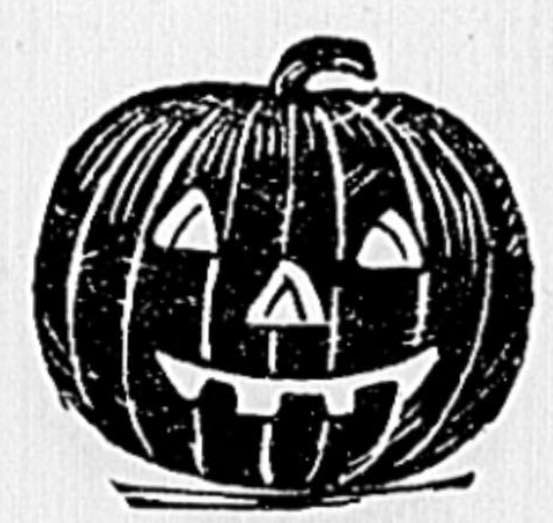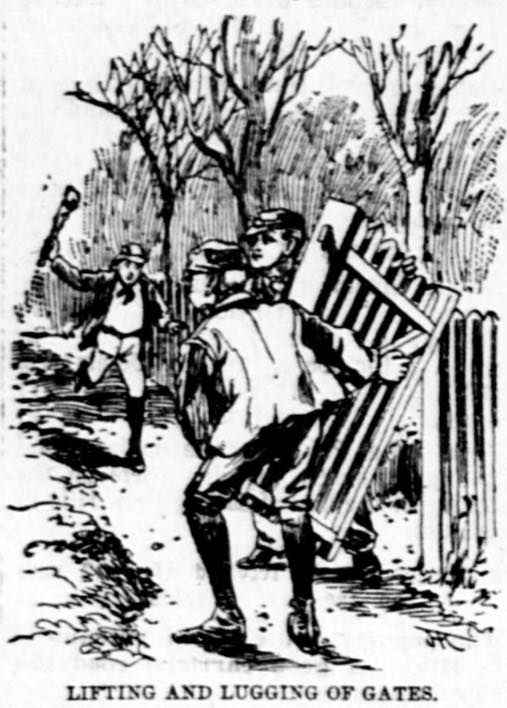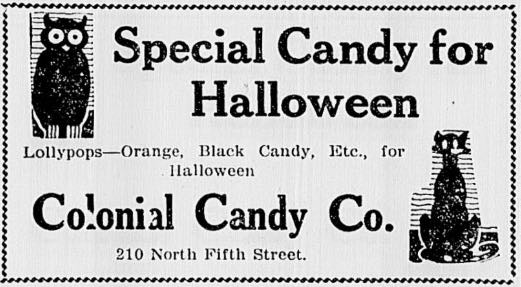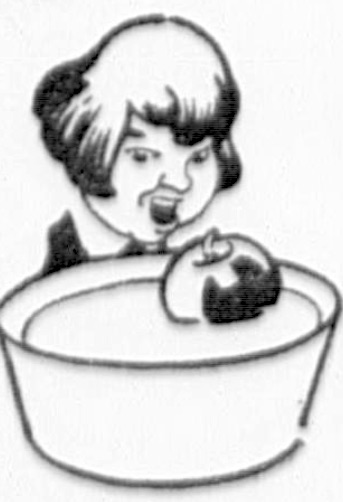
This newspaper article, published in 1912, covers some of the ways Halloween was celebrated in the recent past. While some of the info on the origin of Halloween is inaccurate or dead wrong, the observances and folk customs are accurate.

Halloween
DO you believe in fairies? Or have you grown beyond the age when you think the goblins will get you if you don’t watch out? It makes no difference how old you may be or how lacking in superstition, you are still interested in those many little beliefs and signs and omens which took up such a large part in your childhood fancy. And you are willing, if only for one day in the year — Halloween — to conjure up childish memories and either to join in or encourage the old fashioned idea of celebrating this hallowed evening?
Thursday evening next, October 31, fun and frolic will again hold sway among a very big percentage of all youngsters, especially those of the English speaking countries, as well as among a good number of their elders, for Halloween, or All Halloween, as it is sometimes known, will be observed with all its characteristics, wild outbursts of youthful deviltry and merrymaking.
Present Observations
Halloween, as observed at the present time, is regarded by most people as a day primarily intended for the urchin. It is true that grown-ups do not engage as enthusiastically in the day’s celebration as the younger element, yet it was not always so. Queen Victoria once assisted in a Halloween festival at Balmoral Castle, where a fire was built and effigies of goblins and witches were burned, and we have written record of the day as celebrated by various English kings and Scottish chiefs with religious ceremonies similar to our Halloween or All Saints’ day of November.
Halloween derives its name from its being the vigil of All Saints’ day. The Druids, away back before the birth of Christ, set apart October 31 as a night for the extinguishment of all fires and the rekindling of new ones. All the supernatural beings of the visible and invisible world were supposed to gather on this night and hold high revel in the sphere of humanity, and the fires were rewarded as charms against these spirits. “Witches’ night” and “Devils’ Sunday” were the common terms used by the pagan folks [no, it was not]. As late as the seventeenth century the farmers in Brittany carried lighted torches about their fields to protect themselves from the evil forces of the coming year [to protect their fields from blight and insects]. So it is seen that Halloween, which was at first purely a pagan custom of the Druids, has become a period about which mystery has clung so fixedly that it still remains a day of special celebration.

Irish, Scotch, and Welsh
Halloween is most widely observed by the Irish, Scotch and Welsh. In Scotland any child born on the eve of October 31 is supposed to be endowed with a mysterious faculty of holding communion while sleeping with the invisible world. In north Wales the peasantry cast stones into a great fire, and after covering them up with ashes retire to rest. The next morning the ashes are swept aside and the stones sought, and woe betide those who do not find their stones. Their future life, it is supposed, will be very uncertain.
Upon some of the Channel Islands the fisherfolk choose Halloween to propitiate a sea god whom they know as “Shony.” At night they gather at the seacoast, brew ale and consign it to the waves, meanwhile repeating the words: “Shony, I give you this cup of ale, hoping you will be so kind as to send us plenty of seaward to enrich our land the coming year.” Afterward they return to a church and offer prayer to God, following which revelry of all kinds is participated in. In sections of Ireland Halloween is kept in all its entireties. Burns has ludicrously embodied the customs of the Irish in his poem “Halloween,” in which the general good fellowship, nut roasting, apple ducking, dumb cake ceremony and candle singeing are quaintly described.

Dumb Cake
The dumb cake ceremony is a common custom in Ireland on Halloween night. A piece of cake is kneaded with the left thumb in absolute silence. If the lips are even slightly moved the charm will be broken. However, if nothing is said presently there will appear the future husband of the faithful lass. Another prevalent custom has to do with molten lead, which is cast into cold spring water. The fanciful shapes resulting denote the kind of husband a girl will get. For instance, if the lead takes the appearance of a dragon the resemblance is at once compared, and the eager girl is told of the result.
Now bring forth the lead and melt it down quickly,
There is no knowing what is in store for you yet;
Here, Harry, run out for a key of the gateway,
And, Betty, a bowl of fresh water get.
So hold the key over and through the wards pour,
Until the lead runs down like meal through a sieve;
Remember, remember, on nutty November,
The charm is completed at gay Halloweve.
Cabbage stalks are often used as a means of telling fortunes. A little verse relating “Murtagh’s Evil” is usually chanted before the cabbages are chosen. It runs:
One, two, three and up to seven,
If all are white all go to heaven;
If one is black as “Murtagh’s Evil,”
He’ll soon be screeching with the devil.
“Murtagh’s Evil” is likely a very black crime, in view of the fact that it is placed in the verse so connectedly with the devil’s name.

Hempseed
Burns has inimitable described, in “Halloween,” the various superstitious practices of the Irish peasantry of his time, and especially interesting are the ones known as “Kaling,” “Toomdish,” “Sarksleeve” and “Hempseed.” In the Kaling procedure blindfolded persons of all one sex go out into the fields and after pulling up the first stalks they touch tell the size, appearance and character of their future mates by the size, straightness and crookedness of their stalks. The dirt clinging to the stock denotes the dowry or fortune, and the taste of the pith the temper of the husband or wife-to-be. They are then put one after another over the door and the names of the persons in the succession of their entrance through it are the same as the names of the mate of the holder of that particular stalk.
In the “Toomdish” or “Luggies,” three dishes, one filled with clean water, another with dirty water and the third with no water, are placed on a table in a row. A blindfolded person then dips his head into the first dish he touches, and if he succeeds in locating the clean water his wife will have been unmarried, if he touches the dirty water his wife will have been a widow, and if he plunges his hand into the empty dish he will remain a bachelor.
The “Sarksleeve” method consisted of dipping the left shirt sleeve in a stream at nighttime. Then upon going to bed in sight of a fire, the shirt sleeve being hung up to dry, at midnight the future partner in life of the owner of the shirt glides up and turns the sleeve from the left side over to the right to dry. Needless to say there have been many weird and interesting stories due in most part to the “barley brue” with which the swain had screwed up his courage. The “Hempseed” superstition as described by Burns lies in the sowing of a handful of hempseed at night, and then harrowing with anything conveniently drawn, and afterward repeating a prayer. The apparition being summoned duly appears upon one’s looking over one’s shoulder.

German, Celtic, and Latin
Although Halloween by the Teutonic and Celtic peoples was observed in fun making and frolic, to the Latin peoples it is a religious vigil. All Saints’ day on November 1 is universally a Catholic festival. It had its origin in the year 610 A.D., when the old Roman temple, Pantheon, that had hitherto been dedicated to the pagan gods, was consecrated to the worship of the Virgin Mary and the martyrs. The reason for fixing the day on November 1 was to supplant pagan observances of Halloween. Eventually pagan and Christian customs blended and consequently the right of the Druids became intermingled with various of the Christian observances, and thereupon instead of “Witches’ night,” “Devil’s Sunday,” “Nutcrack Night” or “Walpurgis Night,” the designation All Halloween or Halloween from All Saints’ day was generally used.
In Germany the Walpurgis night was in the most par closely allied to Halloween, for upon this night, the eve of May 1, fires were built on the summit of the Brocken in the Harz mountains with the same object in view as that of the Celtic peasantry — to drive away the evil spirits. Nutcrack night, as Halloween is sometimes called, originated from the festival held in honor of Pomona, goddess of orchards. Roman boys in Horace’s time participated in sports in which nuts figured, and there was also religious use made of them, so that the probable origin of the conspicuous part played by nuts in the Halloween customs of the present day dates back to Rome in the early centuries.

Apples
Apples also play a prominent part in all Halloween celebrations, and the reason is found in the observance long, long ago if the day called “La Mas Ubhalt,” November 1, which was dedicated to the angel presiding over fruits and seeds. The pronunciation, which was Lamasool, became corrupted into Lamb’s wool, which term was applied to a Halloween beverage in Ireland made of roasted apples, liquor and milk. This drink seems to have been the first apple toddy — at least it was not much different from the apple toddy of today. The most prominent part played by apples in Halloween gatherings today is in Ireland, where every child on Halloween day sends an apple to the Allen market at St. Ives, but all over the world, wherever Halloween is celebrated, lads and maidens bob for apples, roast the delicious fruit and eat it before a looking glass in order to conjure up the inquirer’s future mate. Burns thus writes of a small girl:
Wee Jennie to her granny says:
“Will you go with me, granny?
I’ll eat the apple at the glass,
I got from Uncle Johnny.”
Source: Evening Star. Newspaper. October 27, 1912.

